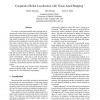Free Online Productivity Tools
i2Speak
i2Symbol
i2OCR
iTex2Img
iWeb2Print
iWeb2Shot
i2Type
iPdf2Split
iPdf2Merge
i2Bopomofo
i2Arabic
i2Style
i2Image
i2PDF
iLatex2Rtf
Sci2ools
ICRA
1999
IEEE
1999
IEEE
Cooperative Robot Localization with Vision-Based Mapping
Two stereo vision-based mobile robots navigate and autonomously explore their environment safely while building occupancy grid maps of the environment. A novel landmark recognition system allows one robot to automatically find suitable landmarks in the environment. The second robot uses these landmarks to localize itself relative to the first robot's reference frame, even when the current state of the map is incomplete. The robots have a common local reference frame so that they can collaborate on tasks, without having a prior map of the environment. Stereo vision processing and map updates are done at 5Hz and the robots move at 200 cm/s. Using occupancy grids the robots can robustly explore unstructured and dynamic environments. The map is used for path planning and landmark detection. Landmark detection uses the map's corner features and least-squares optimization to find the transformation between the robots' coordinate frames. The results provide very accurate relat...
| Added | 03 Aug 2010 |
| Updated | 03 Aug 2010 |
| Type | Conference |
| Year | 1999 |
| Where | ICRA |
| Authors | Cullen Jennings, Don Murray, James J. Little |
Comments (0)

